Americans are fat
Currently 2/3 of the US population is overweight or obese. We generally eat too much, eat the wrong things, and don’t exercise. You know things are bad when the US Coast guard reduced the number of passengers allowed on boats because the “Average American” is 9% heavier than the last time they measured.
I don’t feel fat and yet I was surprised to find that my body mass index (BMI) puts me in the borderline overweight category. My BMI was 24 (24-30 is overweight, and <30 is obese). It can be a dose of reality, so check your BMI on the Mayo Clinic calculator.
. . . and getting fatter
Currently, Colorado (COL is in the middle of the country) is the only state where the number of obese people is under 20%. Sad. But in 1995, that percentage would have made Colorado the worst in the nation. Basically, our slimmest state (COL) would have been the fattest in 1995. Read more here.
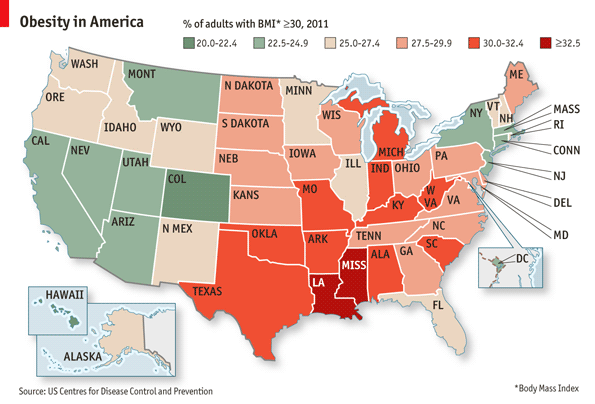
The states with the largest % of obese citizens are Louisiana (LA), Mississippi (MISS) and the surrounding states. Perhaps it is the prevalence of fried foods and the love of butter. Yes, fried chicken is delicious, but more than likely the root cause is poverty.
Sad to say, but poor people eat poorly
When you are wealthy, you have more leisure time to exercise, more discretionary money (some joke that “Whole Foods” should be called “Whole Paycheck”), and access to good groceries. It is an odd problem. In so many places, it is easier to buy french fries than fruit or vegetables.
The USDA defines places where it is difficult to reach a supermarket or large grocery store (1 mile in the city, 10 miles in rural areas) as “nutrition deserts.” On the map below, the areas shown in pink are places where people have a tough time finding decent food. Instead, they are more likely to eat fast food, canned food, and things filled with stupid calories and fillers – sugar, corn syrup, nitrates and other non-nutritional oddities.
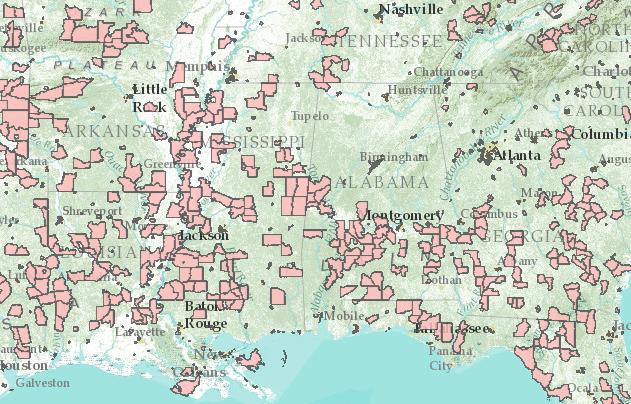
Obesity kills
Obesity creates all sorts of health problems such as diabetes, high blood pressure, high cholesterol, liver disease, sleep apnea, and joint pain. Apparently, the number of Americans diagnosed with diabetes tripled to 21M over the last 25 years. (Weight of the Nation documentary on HBO). Perhaps it is best summed up in this animated 3 minute video by Alex Bogusky (advertising super-star) and Jason Mraz musician about the dangers of drinking too many sugary soda drinks.
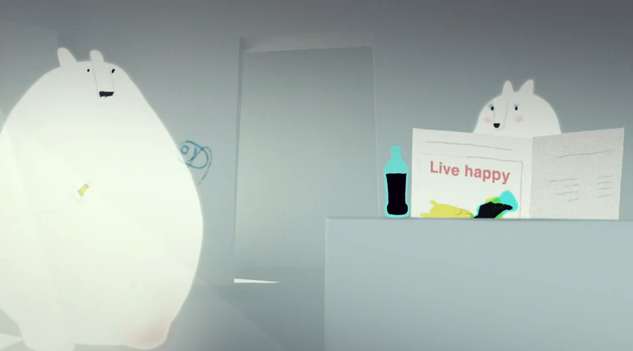
Obesity is expensive
According to a CDC report, “In 2008, the annual medical costs associated with obesity were estimated at $147 billion.” Even that seems like a low estimate because a separate report from the Institute of Medicine puts the obesity-related healthcare costs at $550 billion a year by 2030.
In addition to that, the obese workforce costs American businesses an estimated $73B per year. So, it is no wonder that companies have wellness programs that try to encourage employees to lose weight, stop smoking etc. In this story, one IBM employee lost 16 pounds and was given $1,800 in return.
What should we do?
As a consultant, I often think through problems tops-down and try to group the root causes (and the potential solutions) into a few buckets. After a bit reading on the topic of obesity, it looked like this:
- We consume too many (and the wrong types of) calories
- We don’t exercise enough. No argument there either
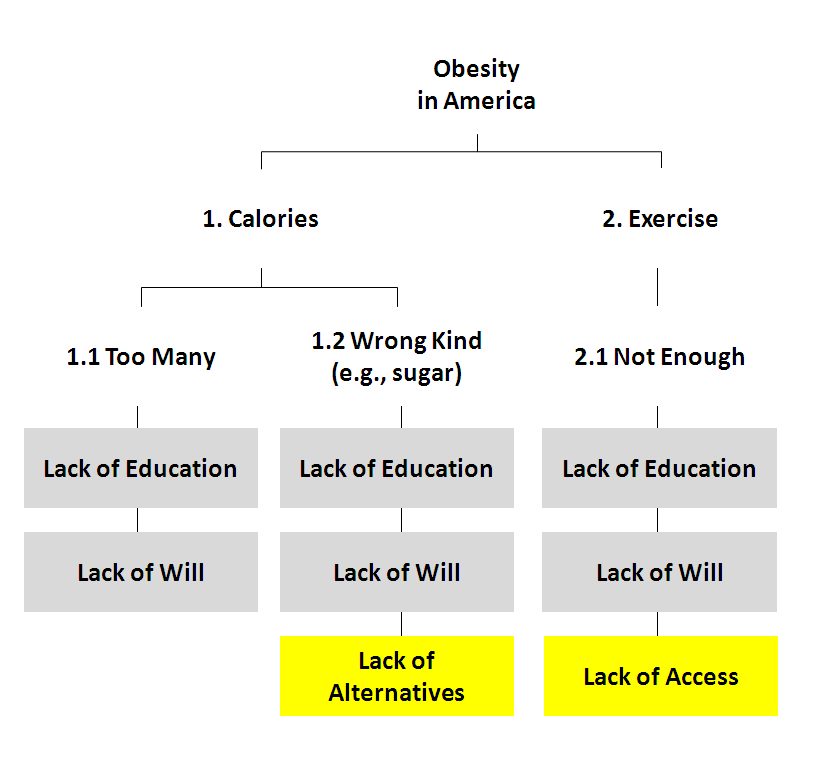 GRAY BOXES:
GRAY BOXES:
The real surprising takeaway was that A LOT of the problem has to do with a lack of education and the will power to fix it. As a society, we need to get smart on the topic, and encourage each other and our kids to live healthier lives.
YELLOW BOXES:
There are certainly things that governments, schools, civic organizations can help solve. They can provide better alternatives (healthier foods in schools, fewer nutritional deserts) and better access (exercise in public schools, bike and walking paths). That said, the majority of the “fix” is in the gray boxes.
Kids don’t know food
Chef Jamie Oliver has a condemning TED talk about how kids are learning the wrong things about food in schools. The food at public schools (31M meals served daily) are full of processed, canned and frozen foods. That is what they see in schools and at home. They aren’t learning life skills. Sadly, they don’t even know what common vegetables look like. In the picture below, the boy thinks this is a potato.

The Biggest Loser – a competitive dieting show – has been hugely popular over the last 10 years. It gives an honest look at how hard it is to lose weight and keep it off. It is a physical and mental battle. Now, they have teenage contestants.
We don’t walk enough
We drive everywhere. Unless you live in a very walkable city like New York, you probably drive 1-2 hours per day. There are so many structural reasons for this – urban planning, public transportation, tax policies, gasoline prices – but the net result is a lot of driving, and not a lot of healthy walking. You can see how your city scores on its “walkability” on www.walkscore.com. My city scored a miserable 31 out of 100 points.
We live sedentary lives. Lots of TV, video games, computer time. Too much blogging? Perhaps we just need to play more outside. The Let’s Move campaign (404 now) thinks so.
Trick ourselves to eat less
Cornell University has a famous Food and Brand Lab where they study eating habits. hey are the guys who came up with the 100 calorie snack packs etc. They discuss Delboeuf’s Illusion where the same amount of food looks like more food when the plate is smaller. See . . . the black circles are the same size, but the one on the left probably looks smaller.
 The smart researchers in Ithaca have also discovered that strong contrasts in color makes food look bigger. So, white pasta on a red plate looks like a lot of food. Conversely, white pasta on a white plate looks small.
The smart researchers in Ithaca have also discovered that strong contrasts in color makes food look bigger. So, white pasta on a red plate looks like a lot of food. Conversely, white pasta on a white plate looks small.
Yes, it’s an epidemic
The US surgeon general called obesity an epidemic. Pretty serious talk. For me, the general consciousness around bad eating habits started about 10 years ago with the publishing of the Fast Food Nation, and the movie Super Size Me about a guy who only eats McDonalds for 30 days. It is free to watch on Hulu and worth your time. It is funny and shocking. It’s no surprise that he gained 24 pounds during the experiment and got pretty sick.
Since then McDonalds has taken a lot of positive steps – they sell water, salad, chicken wraps, publicly post calorie counts. They even cut the sodium in all their menu ideas by 11%. ne newspaper article coined it as stealth health.
Should the government do something?
Libertarians will argue that people should be able to choose for themselves. If they want to eat bad food, not take care of their bodies, and get obese, that is their business. Others would argue that people are not always so rationale, and that there are structural traps – poverty, nutrition deserts, sugar industry subsidies etc – that make it too easy to become obese in the US. If you want to hear some experts argue this topic out, listen to this debate on the topic: Is Obesity the government’s business? here.
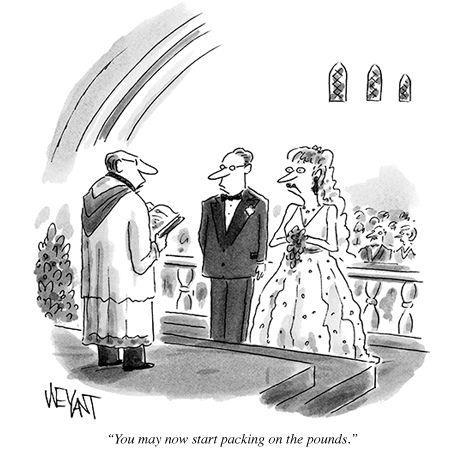
Post script: Special report from the Economist on Obesity here. As usual, great work.
